2¾hp.
Machines for the 1920 Isle of Man T.T.
An article from 'Motor Cycling', 19th May, 1920:
2¾hp.
Racers Develop 10hp.
Full details of high
efficiency junior T.T. machinesThe Stevens brothers, than
whom few people in the motorcycle trade have more experience
in engine building, have produced an extremely efficient
2¾hp. racer for this year's Tourist Trophy. One machine will
be ridden in the senior event, and six in the junior, the
riders being Eric Williams (who will also ride a Sunbeam in
the senior), Howard Davies, Bert Haddock, Harris, Harold
Heath, and O. Wade.
The A.J.S. racer is a
four-speed machine, two sprockets of different size being
mounted on the engine shaft, and driving thence to a double
sprocket machined out of the solid on the countershaft,
where an ordinary two-speed gear is fitted. The latter is
controlled by a lever mounted on the offside of the tank,
whilst the engine-shaft gear, which is changed by clutching
up either sprocket, by means of internally cut dogs, with
the engine shaft, is operated through a rod and Bowden wire
arrangement down the right handlebar.
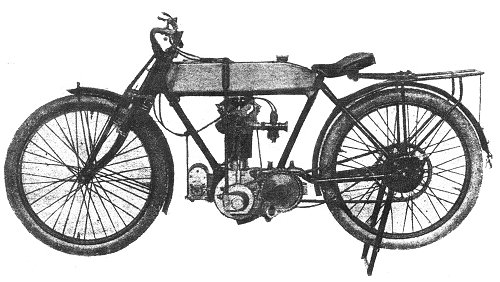
The T.T. A.J.S. simply
bristles with innovations. The new type of gear is
shown in
this view, as is the unique method of saddle springing. |
At present the gear ratios
obtainable are 4⅝, 5½, 7¼, and 8½ to 1, though these may be
modified later after practice in the Isle of Man.
The top
gear is used down long slopes with a view to saving the
engine, which would otherwise be turning over at a terrific
speed.
|
An astounding r.p.m.
has been obtained, and 10hp.
developed by the dynamometer
test by the use of very light
working parts, a very high
compression, and large overhead
valves set at an angle of 45
degrees to each other.
A single
ring drilled steel piston is used in preference to an
aluminium one, as the latter type broke up when tested at Brooklands. The piston is machined out of a solid bar of
steel, as are the flywheels. The connecting rod is a
wonderful piece of work, being machined all over, and as
light as it is possible to make it without risk of fracture.
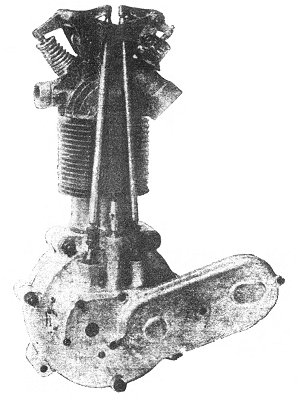 |
A detachable combustion head
with large and smoothly-polished surface and ports, carries
the inlet and exhaust valves, the exhaust port being a good
deal larger than the inlet.
The cylinder head is held down
by a metal strap, which is anchored in the crankcase and
provides a very neat, light and strong fixing.
The overhead
rocker arms and their supports are all made of the highest
grade steel, the arms being operated by hollow tappet rods.
The compression used is 5½ atmospheres. Some trouble has been
experienced in discovering a sparking plug, which will stand
up to the work, but the Cooke plug has now been adopted
after prolonged tests.
The cylinder, like the head, is made
of cast iron. It is machined inside and out, the radiating
fins being a particularly fine piece of work. |
| The tank holds two gallons
of petrol and is provided with extra large filler caps. The
oil filler communicates with its tank, which is clipped to
the rear down tube and holds half a gallon of oil, via a
large passageway, and is arranged thus to facilitate
filling, the oil being pumped into the tank by the rider
himself at the depot.
The two pictures show the
novel construction of the engine. The placing of the valves
at an angle in the head enables those of large diameter
to be used. The top picture also shows the two-speed
countershaft gear which is employed conjointly with an
Enfield type of gear. |
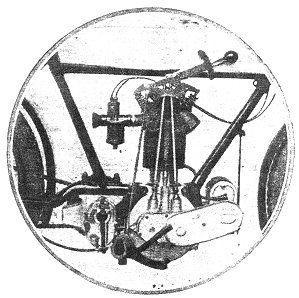 |
|
|
|
An article from the
'Motor Cycle', 10th June, 1920:
A.J.S.
Machines for the T.T.
Four-speed gears applied to
sturdy machines having high efficiency single-cylinder
enginesConsiderable interest will
be taken in A.J.S. machines, which besides defending their
title in the junior race next Tuesday are the only 350c.c.
engines entered for the senior event.
Frame, gearbox, forks, and
brakes are A.J.S. standard practice, but the engine and
certain features of the transmission are new. The
single-cylinder engine has a bore and stroke of 74 x 81 mm
respectively. To all intents and purposes the crank case is
standard, but steel flywheels are used and the cast iron
cylinder has a detachable hemispherical head in which
overhead valves are mounted inclined from the centre line at
approximately 45 degrees.
|
|
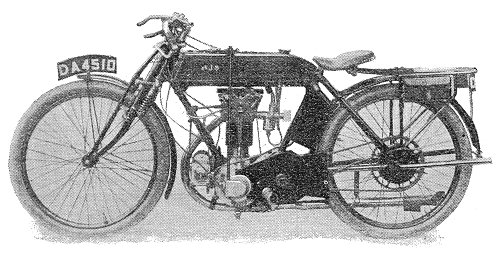
Driving side of the A.J.S.
which will defend the junior trophy.
|
These valves are operated
through standard timing gear and long push rods, overhead
rockers being carried in brackets bolted to the head.
The
fixing of the cylinder head is unusual and very ingenious,
as it is held down by a flexible steel strap passing over
the head of the engine and tightened by turnbuckles on
either side of the crank case. |
| Unorthodox Transmission
A very light steel piston is employed having two
rings at the top and a series of oil grooves,
the lower part of the skirt is copiously
drilled.
The transmission
from the engine shaft to the gearbox is somewhat
unusual, two equal sized sprockets are machined
on the clutch ring, and mounted loosely on an
extension of the crankshaft are two sprockets
which differ slightly in size.
Either of these
sprockets may be dogged to the shaft at will, a
control being operated from the handle bar.
When the smaller
of these sprockets is being utilised for the
drive, the normal high and low gear are obtained
by means of the countershaft gearbox, but the
larger sprocket can be used for long descents,
and gives slightly higher ratios so as to
prevent over-running of the engine. |
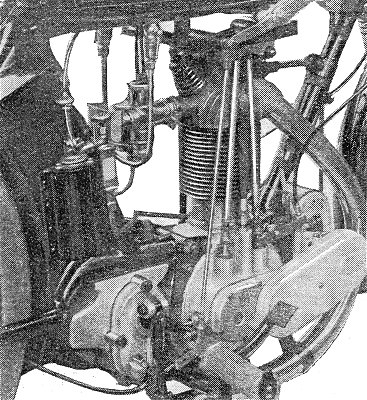
The cylinder head of the
A.J.S. is held down by a steel
strap, and oil is supplied by
a handle-bar controlled
pump from a tank behind the saddle
tube. |
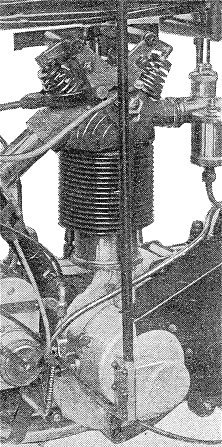
Driving side of the T.T.
A.J.S., showing the housing for the engine shaft gear and
the inclined overhead valves. |
The saddle tank contains
two gallons of petrol, and the entire oil supply is carried
in a tank behind the saddle tube. A somewhat unusual method
of filling this tank is employed, since a large diameter
pipe is carried upwards through the petrol tank so as to
bring the filler cap into a normal and easily accessible
position. Lubrication is effected by a
spring pump controlled from the handle bar, the flow being
regulated by a sight feed drip. It is just possible however,
that this drip will not be used during the race.
From the illustrations, it
will be noticed that the cylinder is stayed to the front
down tube. The machine is fitted with a Brooks saddle, Amac
carburettor, Hans Renold chains, Dunlop tyres, and
Thomson-Bennett large size magneto.
It is a most workmanlike
mount, which has been designed rather with the idea of a
high efficiency machine which will stand up to the work,
than with the idea of saving weight.
A Sporting Chance
There is no doubt that the
A.J.S. stands an excellent chance of retaining its title
since there are few machines which have been so thoughtfully
designed and well constructed. It is unfortunate, therefore,
that T. H. Haddock and N. C. Heath, two of the T.T. riders
of this model, should have suffered accidents during
preliminary practice. Whether these accidents will prevent
their riding in the race is not certain, but we understand
the A.J.S. firm have other good riders in reserve.
|
| That one of these machines
has been entered in the senior event gives the A.J.S. a
sporting chance of winning both events; in any case, its
performance in competition with machines of 30% larger
capacity will be watched with great interest. |
|
 |
Return to the
previous page |
|